Drug Detection Dogs
 Especially trained detection dogs have proved their value in fighting the raising drug-related crime. The breed of the dogs is not so important to meet the basic preconditions for drug detection dog training. So you can find four-leg specialists in all working dog breeds and in all agile hound, retriever and terrier breeds.
Especially trained detection dogs have proved their value in fighting the raising drug-related crime. The breed of the dogs is not so important to meet the basic preconditions for drug detection dog training. So you can find four-leg specialists in all working dog breeds and in all agile hound, retriever and terrier breeds.
Because of their enormous and extremely sensitive olfaction power these animals are able to detect even residues (adhesions) of narcotics, which are not visible for human eyes at all. So we can get information about frequently used stockyards and transport ambushes at the same time. The Drug-Detection Dog is able to detect even marginal quantities of narcotics in ambushes, where you never would search it and where the simple search of humans reaches its limits.
You can use these dogs for searching in and nearby objects, in and at vehicles, in open environment and for scanning of baggage and clothes. The large economy of time during the search is another benefit using Drug detection dogs because they can scan very large areas (e.g. meadows, estates, ground, storehouses etc.) in a very short time. However we must say that the drug detection dog isn’t more than a tool.
Basic premises for the training of Drug Detection Dogs
A dog must meet the following basic premises for becoming a Drug detection dog:









- High fitness and health in general
- Impartial and free of conflict social behavior - also in stress situations
- Able to work under pressure of extreme environmental conditions (extreme weather situation, heavy noise, dust and smell annoyance, noises, movements)
Structure of Drug detection Dog Training
Drug detection dogs are trained with the five basic narcotics (hashish, marihuana, heroin, cocaine, amphetamine). The most common drugs like Ecstasy, GHB, crystal etc. are conditioned also that way. Since it's easier in Germany to get all qualifications and licenses for explosives than drugs for provable training purposes, we can use only smell carriers and substitutes to train the dogs.
The dog will not only have to detect and indicate narcotics that are hidden, packed or even modified (padded out) but also utensils of consumers and packages with narcotic adhesions. In the process dogs must search locations in heights up to 6 feet (maximum).
Unlike to explosives detection dogs, drug detection dogs can indicate there detections in an active manner (barking, biting, scraping). We prefer, however, the passive kind of indication from the first beginning in order to avoid damages of expensive arrangements of flats and houses, clothes and vehicles. Furthermore it is easier to find companies and shops providing their rooms and locations for training purposes in this way.

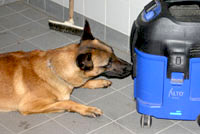
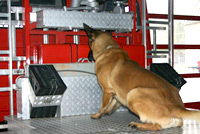
Another important goal of the training course is the practical and theoretical education of the K9 handler in:
- Legal issues and premises for using a Drug detection dog
- Cynology of the dog
- Operation tactics
- Poisoning treatment
- Rules of behavior in handling narcotics
- Substance knowledge(knowledge about types of consume and the effects of the single substances)
- Practical relevant training in affected locations, at vehicles and in free environment including scanning of clothes and luggage
Goals of Drug detection Dog Training
The Drug detection dog is trained and used to find and indicate narcotics, utensils of consumers and packages with adhesions mainly in unknowable ambushes like wood cladding, power sockets, braces, filters, tubes, earth depots etc. for some things. These ambushes can be located in heights up to 6 feet.
Fields of Application for Drug detection Dogs



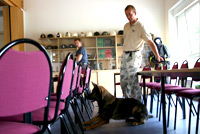

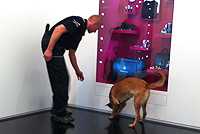

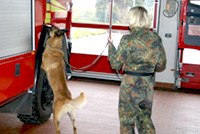







Certification of Drug detection Dogs
The drug dogs are checked in all ranges of use at the named basic narcotics during several days. They must be able to detect and indicate all substances in different ambushes and heights.



